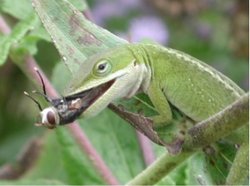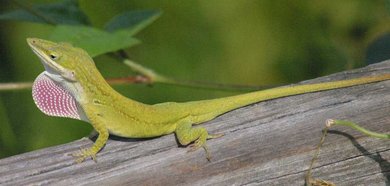Carolina Anole
|
|
| Carolina Anole | ||||||||||||||||
|---|---|---|---|---|---|---|---|---|---|---|---|---|---|---|---|---|
 Anolis carolinensis | ||||||||||||||||
| Scientific classification | ||||||||||||||||
| ||||||||||||||||
| Binomial name | ||||||||||||||||
| Anolis carolinensis Linnaeus, 1758 | ||||||||||||||||
| Subspecies | ||||||||||||||||
|
The Carolina Anole (Anolis carolinensis), also known as the Green Anole, is an aboreal lizard found primarily in the southeastern parts of the United States and some Caribbean islands. It was described by Voigt in 1832 and Carolus Linnaeus in 1758 (as Lacerta principalis, fide Duméril and Bibron 1837: 121). Common synomyns include the American Anole and Red-throated Anole. It is sometimes referred to as the American chameleon due to its color-changing abilities, although it is not a chameleon.
| Contents |
Description
This lizard can reach a total length of about 22 cm. Females are slightly smaller (about 16 cm). The male has a dewlap -- pink or red in color -- that he can extend from his chin as a courtship or territorial display. This dewlap display is often accompanied by head bobbing and "pushups." Green Anoles can have a green or a brown body color, depending on mood, time of day, surroundings, and temperature, with a white underbelly. Males are of solid color across the back, and females have a white stripe along the backbone.
As a defense mechanism, their tails detach with mild force, but missing tails will regenerate. The lost tail piece is left twitching as a distraction as the lizard escapes. Also, like a chameleon, their eyes move independantly of one another.
Distribution
This species is native to the United States where it is found mainly in the southeastern parts of the country. They are sometimes kept as pets. Anoles periodically shed their skins.
Diet
These lizards feed on various insects and other invertebrates. They may also eat pollen and nectar.
Behavior
When caught and held, anoles will protest violently for the first few minutes by jumping around and holding their jaws open to bite; but thereafter they calm down and become rather compliant.
nl:RoodkeelanolisFafnirShedding.jpg


